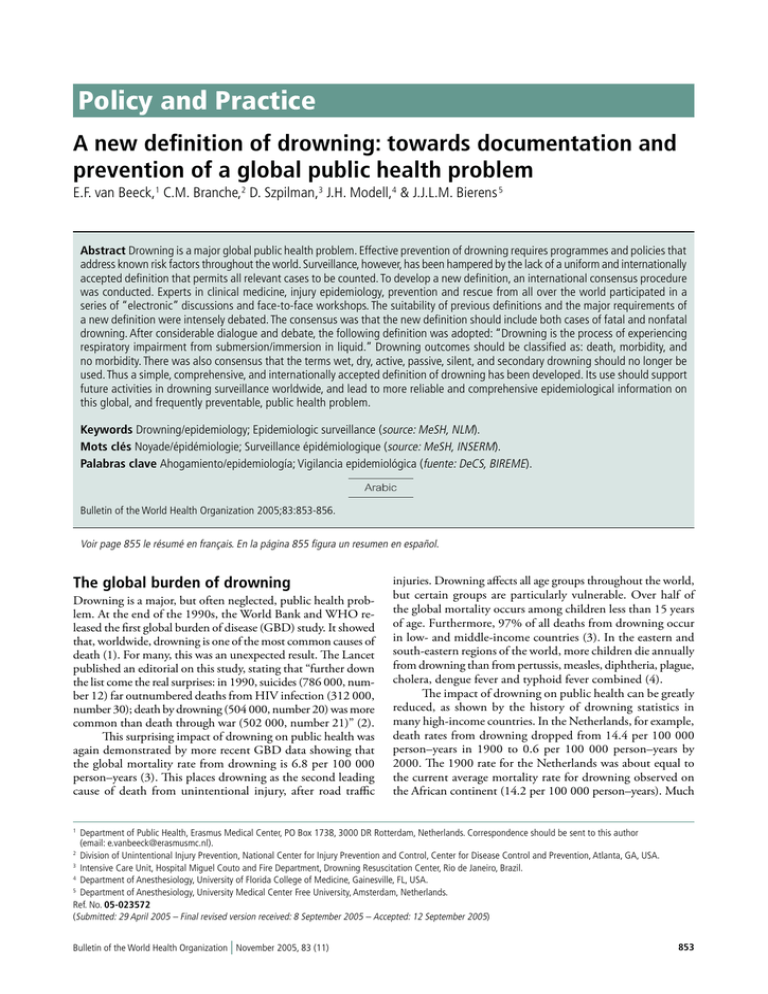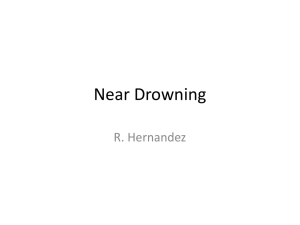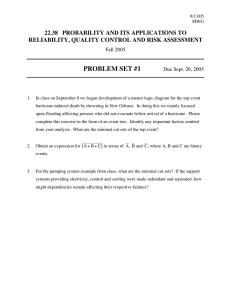A new definition of drowning: towards documentation and E.F. van Beeck,
advertisement

Policy and Practice A new definition of drowning: towards documentation and prevention of a global public health problem E.F. van Beeck,1 C.M. Branche,2 D. Szpilman,3 J.H. Modell,4 & J.J.L.M. Bierens 5 Abstract Drowning is a major global public health problem. Effective prevention of drowning requires programmes and policies that address known risk factors throughout the world. Surveillance, however, has been hampered by the lack of a uniform and internationally accepted definition that permits all relevant cases to be counted. To develop a new definition, an international consensus procedure was conducted. Experts in clinical medicine, injury epidemiology, prevention and rescue from all over the world participated in a series of “electronic” discussions and face-to-face workshops. The suitability of previous definitions and the major requirements of a new definition were intensely debated. The consensus was that the new definition should include both cases of fatal and nonfatal drowning. After considerable dialogue and debate, the following definition was adopted: “Drowning is the process of experiencing respiratory impairment from submersion/immersion in liquid.” Drowning outcomes should be classified as: death, morbidity, and no morbidity. There was also consensus that the terms wet, dry, active, passive, silent, and secondary drowning should no longer be used. Thus a simple, comprehensive, and internationally accepted definition of drowning has been developed. Its use should support future activities in drowning surveillance worldwide, and lead to more reliable and comprehensive epidemiological information on this global, and frequently preventable, public health problem. Keywords Drowning/epidemiology; Epidemiologic surveillance (source: MeSH, NLM). Mots clés Noyade/épidémiologie; Surveillance épidémiologique (source: MeSH, INSERM). Palabras clave Ahogamiento/epidemiología; Vigilancia epidemiológica (fuente: DeCS, BIREME). Bulletin of the World Health Organization 2005;83:853-856. Voir page 855 le résumé en français. En la página 855 figura un resumen en español. The global burden of drowning Drowning is a major, but often neglected, public health problem. At the end of the 1990s, the World Bank and WHO released the first global burden of disease (GBD) study. It showed that, worldwide, drowning is one of the most common causes of death (1). For many, this was an unexpected result. The Lancet published an editorial on this study, stating that “further down the list come the real surprises: in 1990, suicides (786 000, number 12) far outnumbered deaths from HIV infection (312 000, number 30); death by drowning (504 000, number 20) was more common than death through war (502 000, number 21)” (2). This surprising impact of drowning on public health was again demonstrated by more recent GBD data showing that the global mortality rate from drowning is 6.8 per 100 000 person–years (3). This places drowning as the second leading cause of death from unintentional injury, after road traffic injuries. Drowning affects all age groups throughout the world, but certain groups are particularly vulnerable. Over half of the global mortality occurs among children less than 15 years of age. Furthermore, 97% of all deaths from drowning occur in low- and middle-income countries (3). In the eastern and south-eastern regions of the world, more children die annually from drowning than from pertussis, measles, diphtheria, plague, cholera, dengue fever and typhoid fever combined (4). The impact of drowning on public health can be greatly reduced, as shown by the history of drowning statistics in many high-income countries. In the Netherlands, for example, death rates from drowning dropped from 14.4 per 100 000 person–years in 1900 to 0.6 per 100 000 person–years by 2000. The 1900 rate for the Netherlands was about equal to the current average mortality rate for drowning observed on the African continent (14.2 per 100 000 person–years). Much Department of Public Health, Erasmus Medical Center, PO Box 1738, 3000 DR Rotterdam, Netherlands. Correspondence should be sent to this author (email: e.vanbeeck@erasmusmc.nl). 2 Division of Unintentional Injury Prevention, National Center for Injury Prevention and Control, Center for Disease Control and Prevention, Atlanta, GA, USA. 3 Intensive Care Unit, Hospital Miguel Couto and Fire Department, Drowning Resuscitation Center, Rio de Janeiro, Brazil. 4 Department of Anesthesiology, University of Florida College of Medicine, Gainesville, FL, USA. 5 Department of Anesthesiology, University Medical Center Free University, Amsterdam, Netherlands. Ref. No. 05-023572 (Submitted: 29 April 2005 – Final revised version received: 8 September 2005 – Accepted: 12 September 2005) 1 Bulletin of the World Health Organization | November 2005, 83 (11) 853 Policy and Practice A new definition of drowning of this spectacular decrease in drowning rates can be attributed to preventive measures, including improved swimming abilities (5). Need for surveillance Drowning must be recognized as a major global public health problem with significant opportunities for prevention. Effective prevention of drowning requires programmes and policies that address known risk factors. Local data collection or surveillance is needed to identify specific factors associated with drowning in a particular region. There may be large variations by time and place because drowning may be related to several types of daily and/or recreational activities (e.g. fishing, boating, swimming), various types of exposure to water (e.g. in oceans, garden wells, lakes, swimming pools and bath tubs) and other risk factors (e.g. behavioural risk factors, including alcohol use and product safety-related factors). For many decades, the collection of data for epidemiological purposes has been hampered by the lack of a uniform and internationally accepted definition which includes both fatal and nonfatal drowning. To improve surveillance, a simple but comprehensive definition is needed. Within the framework of the first World Congress on Drowning (WCOD), held in Amsterdam, Netherlands in 2002, such a definition was developed by means of a consensus procedure (6). This procedure was initiated in 1999 with the release of a discussion paper on the definition of drowning on the website of the WCOD (www.drowning.nl), which provoked lively “electronic” discussions among experts around the world. On the basis of these discussions, a draft of a tentative new definition was published in 2000 by the International Liaison Committee on Resuscitation in collaboration with the American Heart Association (7). The debate continued in the years preceding and during the WCOD, in the course of which many experts in the fields of injury epidemiology, prevention, rescue and clinical medicine participated in a series of discussions and workshops focusing on the suitability of previous definitions and the requirements for a new definition. Suitability of previous definitions In the past it has been customary to use separate definitions for fatal (referred to as drowning) and nonfatal cases (referred to as near-drowning) and to make a further distinction between cases with or without aspiration. Modell proposed a series of definitions in 1971 (8) and slight modifications in 1981 (9), which led to the adoption of the following terminology: • drown(ing) without aspiration: to die from respiratory obstruction and asphyxia while submerged in a fluid medium; • drown(ing) with aspiration: to die from the combined effects of asphyxia and changes secondary to aspiration of fluid while submerged; • near-drown(ing) without aspiration: to survive, at least temporarily, following asphyxia due to submersion in a fluid medium; • near-drown(ing) with aspiration: to survive, at least temporarily, following aspiration of fluid while submerged. These definitions were judged by the 2002 consensus experts to be difficult to use in surveillance and epidemiological research, because they mix characteristics of the event (e.g. submersion and immersion) with the pathophysiological changes (e.g. 854 E.F. van Beeck et al. asphyxia, electrolyte and blood volume changes, and a wide variety of alterations in respiratory function), and the outcome (mortality and morbidity). During the consensus procedure, the advantages and disadvantages of having separate definitions for fatal and nonfatal cases were intensively debated. The consensus was that having an outcome classification (drowning = death, near-drowning = survival) as part of the case definition was still cumbersome. Such a classification is different from what is customary with respect to other medical conditions and injuries. Furthermore, such a classification is not in accordance with the internationally accepted Utstein style, which was developed by investigators from different specialties to provide a common language and terminology for cardiac arrest studies (10). It was also recognized that the use of two separate definitions might lead to a continued underestimation of the drowning problem. In the GBD studies, for example, the consequences of nonfatal drowning have been neglected. Major requirements for a new definition The consensus experts agreed that the new definition should be simple, inclusive (including all relevant cases), and specific (excluding irrelevant cases). Furthermore, the terminology should be in accordance with the Utstein style and with common definitions of other medical conditions and injuries. Therefore, the definition should not be confused with systems to describe the etiology or to classify the outcome of the drowning process. The definition should ensure that all victims of drowning have some important unique characteristic in common. This unique criterion is respiratory impairment due to exposure of the patient’s airway to liquid. This induces a cascade of reflexes and pathophysiological changes, which, if uninterrupted, will lead to death, primarily due to tissue hypoxia. Impairment of the respiratory system is secondary to voluntary breath-holding, involuntary laryngospasm and aspiration of water, and the consequences thereof. The definition should include cases of drowning in all kinds of liquid, except body fluids (vomitus, saliva, milk and amniotic fluid) and should exclude a water rescue case (i.e. all submersion or immersion events in which no respiratory impairment is evident, whether with or without other injury). A new definition of drowning On the basis of an analysis of the problems with the existing definitions, a list of requirements, and major input from many experts, the following definition was adopted by consensus of the conference attendees in 2002: “Drowning is the process of experiencing respiratory impairment from submersion/immersion in liquid.” Furthermore, drowning outcomes should be classified as: death, morbidity, and no morbidity. A very slight modification of the wording of this definition, but no change in substance, has been published by Idris et al. (11). To fully understand the breadth of the physiological responses that occur during “drowning”, a familiarity with the “drowning process” is essential. The “drowning process”, as described in the definition and by Idris et al. (11) is the continuum that begins when the victim’s airway lies below the surface of the liquid, usually water, at which time the victim voluntarily holds his or her breath. Breath-holding may be followed by an involuntary period of laryngospasm secondary to the presence of liquid in the oropharynx or larynx. During Bulletin of the World Health Organization | November 2005, 83 (11) Policy and Practice E.F. van Beeck et al. this period of breath-holding and laryngospasm, the victim is unable to breathe gas. This results in oxygen being depleted and carbon dioxide not being eliminated. The victim then becomes hypercarbic, hypoxaemic and acidotic. Because hypercarbia stimulates respiration, the victim’s respiratory movements become very active, but there is no exchange of air because of the obstruction or impairment at the level of the larynx. As the victim’s arterial oxygen tension drops further, laryngeal spasm and obstruction abate, and the victim actively breathes liquid. The amount of liquid inhaled varies considerably from victim to victim. Changes occur in the lungs, body fluids, blood–gas tensions, acid–base balance and electrolyte concentrations, which are dependent on the composition and volume of the liquid aspirated and the duration of submersion. A victim can be rescued at any time during the drowning process and may not require any intervention, or may receive appropriate resuscitative measures, in which case the drowning process is interrupted. The victim may recover from the initial resuscitation efforts, with or without subsequent therapy to eliminate hypoxia, hypercarbia and acidosis, and normal organ function may be restored. However, if the victim’s lungs are not ventilated in a timely fashion, or he or she does not start to breathe air spontaneously, circulatory arrest will ensue, and, in the absence of effective resuscitative efforts, multiple organ dysfunction and death will result, primarily because of tissue hypoxia. All these events are covered by this new definition of drowning. Recent publications (12, 13) have raised questions as to whether “dry” drowning actually occurs or whether its victims died of another cause. Also, victims labelled as having experienced “passive” or “silent” drowning may not have been passive A new definition of drowning or silent at all but simply were not observed. Finally, “secondary” drowning is a misnomer because people who develop acute respiratory distress syndrome after drowning have not undergone a second submersion episode. Thus, we believe the terms “wet”, “dry”, “active”, “passive”, “silent” and “secondary” should no longer be applied to describe a drowning victim. The proposed new definition of drowning is expected to support future activities in worldwide drowning surveillance. This should lead to more reliable and comprehensive information on this public health problem. Only following worldwide implementation will it be possible to determine whether the new definition is actually better suited for epidemiological purposes and whether the major requirements listed have been met. Researchers are invited to use the new definition and to report on the advantages and disadvantages they observe. It is recommended that all water safety and health organizations involved follow WHO (3) and Centers for Disease Control and Prevention (14) in adopting the new definition and include it in their glossaries. We expect that this will lead to a more inclusive description of the global drowning problem and the identification of specific risk factors in specific regions. If our expectations are correct, the new definition of drowning will more accurately quantify, and finally help to reduce this global, but frequently preventable, public health problem. O Funding: We wish to acknowledge the Society to Rescue People from Drowning in the Netherlands for initiating and supporting the World Congress on Drowning 2002 and the international consensus procedure on a new definition of drowning. Competing interests: none declared. Résumé Nouvelle définition de la noyade pour mieux documenter et prévenir un problème mondial de santé publique La noyade constitue un problème de santé publique majeur. Une prévention efficace suppose l’application de programmes et de politiques permettant de faire face à des facteurs de risque connus dans le monde entier. La surveillance a toutefois été rendue plus difficile par l’absence d’une définition homogène internationalement acceptée permettant de comptabiliser tous les cas pertinents. Une nouvelle définition faisant l’objet d’un consensus a donc été élaborée au niveau international. Des experts en médecine clinique, en épidémiologie des traumatismes, en prévention et en secourisme du monde entier ont participé à une série d’ateliers ainsi qu’à des discussions par courrier électronique. Un examen approfondi a eu lieu pour déterminer si les définitions précédentes étaient appropriées et quels devraient être les principaux éléments d’une nouvelle définition. Le consensus auquel les experts ont abouti était que la nouvelle définition devait englober tous les cas de noyade, mortels ou non. Après un dialogue et un débat prolongés, la définition suivante a été adoptée : « La noyade est une insuffisance respiratoire résultant de la submersion ou de l’immersion en milieu liquide. » Les issues de la noyade seront classées de la manière suivante : décès, séquelles et absence de séquelles. Les experts ont également convenu par consensus qu’il ne fallait plus utiliser les expressions noyade mouillée, sèche, active, passive, silencieuse ou secondaire. Ainsi, une définition simple, complète et internationalement acceptée de la noyade a été mise au point. Son utilisation devrait permettre d’appuyer les activités futures de surveillance de la noyade dans le monde et fournir des informations épidémiologiques plus fiables et plus complètes pour traiter ce problème mondial de santé publique, souvent évitable. Resumen Una nueva definición de ahogamiento: hacia una mejor documentación y prevención de un problema mundial de salud pública El ahogamiento es un importante problema mundial de salud pública. Para prevenirlo satisfactoriamente se requieren programas y políticas que aborden los factores de riesgo conocidos en todo el mundo. La vigilancia, sin embargo, se ha visto obstaculizada por la falta de una definición uniforme e internacionalmente aceptada que Bulletin of the World Health Organization | November 2005, 83 (11) permita contabilizar todos los casos pertinentes. A fin de elaborar una nueva definición, se aplicó un procedimiento de consenso internacional. Expertos en medicina clínica, epidemiología de traumatismos, prevención y rescate de todo el mundo participaron en una serie de debates electrónicos y en talleres. Hubo intensas 855 Policy and Practice A new definition of drowning discusiones sobre la idoneidad de las definiciones anteriores y los requisitos principales para una nueva definición. Se consensuó que la nueva definición debía incluir tanto los casos mortales de ahogamiento como los no mortales. Después de muchos debates y conversaciones, se adoptó la siguiente definición: «Se considera ahogamiento el hecho de sufrir dificultades respiratorias como consecuencia de la sumersión o inmersión en un líquido». Los resultados del ahogamiento deberían clasificarse como muerte, morbilidad o ausencia de morbilidad. Hubo también consenso en E.F. van Beeck et al. cuanto a considerar que debían dejar de utilizarse los términos seco, activo, pasivo, silencioso y secundario para calificar los ahogamientos. Así pues, se ha elaborado una definición sencilla, integral e internacionalmente aceptada de ahogamiento, cuyo uso debería contribuir a facilitar las futuras actividades de vigilancia de ese tipo de evento en todo el mundo, así como el acopio de información epidemiológica más fiable y completa sobre este problema mundial, y con frecuencia prevenible, de salud pública. References 1. Murray CJL, Lopez A. Mortality by cause for eight regions of the world: Global Burden of Disease study. Lancet 1997;349:1269-76. 2. Anonymous. From what will we die in 2020? Lancet 1997;349:1263. 3. World Health Organization. Factsheet on drowning. [Online]. Available from: URL: www.who.int/violence_prev…1_injuries/drowning 4. UNICEF/TASC. Towards a world safer for children. Proceedings of UNICEF/ TASC conference on child injury. Bangkok: UNICEF/TASC; 2004. 5. van Beeck EF. Injuries: a continuous challenge for public health [thesis]. Rotterdam, Erasmus University: Enschede, Print partners Ipskamp; 1998. 6. van Beeck EF, Branche CM, Szpilman D, Modell J, Bierens J. Definition of drowning. In: Bierens J et al. editors. Handbook on drowning ; prevention, rescue, treatment. Berlin: Springer Verlag; 2005. 7. The International Liaison Committee on Resuscitation in collaboration with the American Heart Association . Guidelines 2000 for cardiopulmonary resuscitation and emergency cardiovascular care. Part 8: advanced challenges in resuscitation: section 3: special challenges in ecc 3b: submersion or neardrowning. Resuscitation 2000;46:273-7. 856 8. Modell JH. Pathophysiology and treatment of drowning and near-drowning. Springfield, IL: Charles C. Thomas; 1971. p. 4, 8-9. 9. Modell JH. Drown versus near-drown: discussion of definitions. Crit Care Med 1981;9:351-2. 10. Cummins RO. The Utstein-Style for uniform reporting of data from out of hospital cardiac arrest. Ann Emerg Med 1993;22:37-40. 11. Idris AH, Berg R, Bierens J, Bossaert L, Branche C, Gabrielli A, et al. Recommended guidelines for uniform reporting of data from drowning: the “Utstein Style”. Circulation 2003;108:2565-74. 12. Modell JH, Bellefleur M, Davis JH. Drowning without aspiration: is this an appropriate diagnosis? J Forensic Sci 1999;44:1119-23. 13. Lunetta P, Modell JH, Sajantila A. What is the incidence and significance of ‘dry-lungs’ in bodies found in water? Am J Forensic Med Pathol 2004; 25:291-301. 14. Centers for Disease Control and Prevention (CDC). Nonfatal and fatal drownings in recreational water settings – United States, 2001-2002. Morb Mortal Wkly Rep 2004;53:447-52. Bulletin of the World Health Organization | November 2005, 83 (11)







